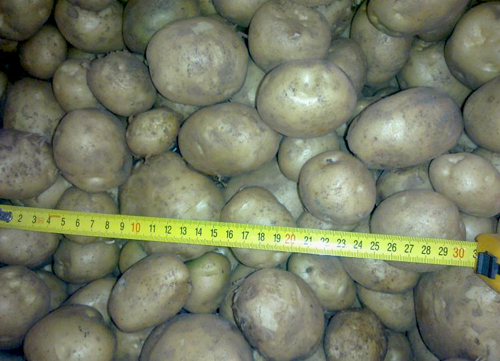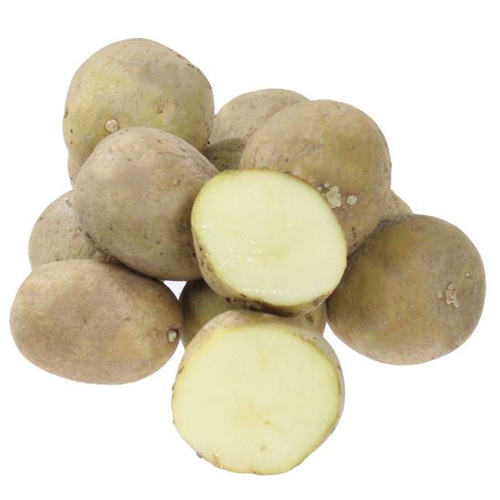Potato variety Elizabeth
Elizaveta is a mid-early table potato variety (Solanum tuberosum) of Russian selection. It is a 7-species hybrid, specialists from the Leningrad Scientific Research Institute of Agriculture “Belogorka” participated in its breeding, namely Osipova E.A., Zueva O.I., Tsarkov N.I., Evdokimova Z.Z. , Pelli A.A., Bryantseva E.V. In 1996, it was included in the state register of plants of the Russian Federation. Approved for cultivation in six regions of the country: North, North-West, Central, Volgo-Vyatka, North Caucasus, Far East. It is considered one of the oldest varieties of domestic breeding that are still in use.
The period from germination to harvest is 65-80 days.

The plant is of medium height, compact. The main stem is erect, the lateral ones are not spreading, abundantly leafy. The leaf plate is large, dark green, slightly pubescent. Corolla is medium in size and white in color. Potato bloom is weak, corollas often fall off, berries are not formed.
In one nest, up to 10 tubers weighing 83-143 grams are formed. Their shape is round, with a blunt top. The rind is light beige, smooth to the touch. The flesh on the cut is white, does not darken on contact with metal or air. The eyes are small, uncolored, superficial, and their number is small.
The yield of Elizaveta potatoes is high, according to the results of state tests, an average of 290-400 centners can be harvested from one hectare of area, which is 39-76 centners / ha more than the indicators of the Nevsky variety. The maximum yield was obtained in the Pskov region - 445 c / ha, 29 c / ha higher than the established standards. According to some reports, the indicator can reach 550 c / ha, and in some years and about 700 c / ha! The marketability of tubers is very high - 79−96%, keeping quality is also quite good - 93%.
The taste is very good. In cooking, tubers are versatile, suitable for preparing various dishes. The pulp has a pleasant texture, does not lose its white color during heat treatment, due to which it looks appetizing when finished. The starch content ranges from 12-18.4%, at the level of the Nevsky standard. The tubers are large and even, the eyes are almost invisible, so the process of peeling potatoes is not difficult.
Elizabeth is not picky about soils, it can grow in a wide variety of climatic latitudes, which is why it has spread throughout almost the entire territory of Russia, including the northernmost regions. The best yield can be obtained on light sod-podzolic, sandy loam, well-cultivated soils. Plants are unpretentious in care, do not require special attention, however, several of the following agrotechnical features must be taken into account.
- This variety is grown mainly according to traditional technology.
- Plants respond well to standard techniques such as loosening and hilling, watering and feeding. Don't forget about weeding.
- A very important point is the preventive treatment of plantings from pests and diseases.

- Elizabeth potatoes have a tendency to form very large tubers, so if you want to get seed, you should carry out chemical combustion or mowing of the tops 2-3 weeks before harvest.
- Maintain crop rotation at the site. The best predecessors are legumes, cabbage, zucchini, cucumber, beets, garlic, onions, green manure.
Plants are resistant to cancer, nematodes, viruses A and Y, common scab. The tubers are moderately resistant to the causative agent of late blight, the tops are more susceptible to it, and in the years of epiphytoties it is strongly affected.
As for pests, there is a separate "scary" story. The fact is that at the end of 2005, information about the approval of genetically modified potatoes called "Elizabeth 2904/1 kgs" for use in food in Russia was spread. This specimen differs in that it is absolutely not affected by the Colorado potato beetle.It was bred in the center of "Bioengineering" of the Russian Academy of Sciences using American technologies based on the domestic variety "Elizaveta", to which this article is devoted. Thus, our hero is completely safe! Of course, he does not resist the Colorado beetle so confidently, but with proper and timely treatment with insecticides, this will not become a serious problem.
Over the long period of its existence, this potato has managed to win the trust of many gardeners. It is especially appreciated for its high yield, amicable ripening of tubers, their good presentation and excellent taste, as well as suitability for long-term storage. Even in seasons with poor weather conditions, plants are capable of producing a fairly large amount of harvest. Among the shortcomings, we can note the susceptibility to late blight in the tops, as well as the tendency to degeneration, which is inherent in many old varieties. Seed material should be renewed approximately every 5-7 years, but this can be difficult since Elizabeth is no longer grown on such a large scale as before. Still, modern varieties have ousted our hero from the wide market. However, this time-tested potato will certainly delight you with its reliability, good yield and unpretentiousness!
The patent holder is Vsevolozhskaya breeding station LLC in the Leningrad Region.
Cultivation is officially carried out by: State Institution Sakhalin Regional Plant Protection Station, FGBNU "Sakhalin Research Institute of Agriculture", LLC "Slavyanka-M" in the Leningrad Region, ONO "Kholmogorsk Experimental Station of Livestock and Plant Breeding" in the Arkhangelsk Region.








